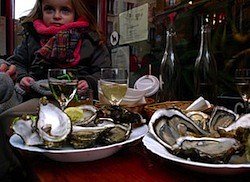Le Baron Rouge

Sat 26 Dec 2009

Le Baron Rouge
1, rue Théophile Roussel, in the 12th Arrondissement.
Tues–Thurs, 10 a.m.–2 p.m. and 5 p.m.–10 p.m.
Fri–Sat, 10 a.m.–10 p.m.; Sun, 10 a.m.–4 p.m.
As a young person growing up in Kansas, I couldn’t imagine anything more disgusting than raw oysters. They seemed slimy, stinky and squirmy—why would any sane person want to pop one in her mouth?
I managed to avoid the mollusk until I was 25 years old, when I was confronted by a raw bar at a friend’s wedding. Trying to fit in at this chic affair, I swallowed my inhibitions and a couple of oysters. To my surprise, I didn’t die. I ate oysters a few more times while living in Boston, but never with much enthusiasm.
That all changed when I moved to France, where fresh oysters during winter are part of the culture. There are more huîtres consumed here than in any other country—around 130,000 tons per year. The majority are pried from gleaming seafood platters in polished restaurants and brasseries. But my favorite place to eat them is on the hood of a parked car.
If you’ve ever been to Le Baron Rouge, the bustling wine bar near the Marché d’Aligre, then you know exactly what I’m talking about. During the cold months, a vendor drives up from the Atlantic coast to sell his huîtres here on Saturday and Sunday mornings. Customers crowd around his sidewalk table to select their preferred size of Arcachon Cap-Ferret before heading inside to search out a glass of chilly muscadet. Prices are easy here—a half dozen on the half shell will run between 5.50 and 9 euros.
For those who can’t snag a seat indoors—and there are only a handful of tables and upturned-barrel surfaces—it’s back out to the sidewalk for the slurp and sip. On crowded mornings, stacks of crates are topped with wood to become makeshift tables. Friends balance their glasses on the tops of recycling bins. And every parked car within 20 feet becomes a counter.

While the atmosphere is 80 percent of the attraction, the oysters themselves are simply delicious. They’re served without fuss—just a bit of lemon and a slice of bread—as befits something to be eaten while leaning against a truck. The accompanying wines are sourced directly from producers and sold for low prices both by the glass and by the liter (for takeaway).
I credit the bustling scene with distracting me from my fear and helping me grow to love the oyster. The weekend oyster feed at Le Baron Rouge is a tradition that you shouldn’t miss while visiting Paris in the winter.
In a nutshell: Plastic plates piled high with raw oysters, eaten on the sidewalk or inside the bustling wine bar. Great wines by the glass, and a selection of charcuterie and cheese for the seafood averse. The oyster man appears on Saturdays and Sundays in winter only, but the wine bar is fun throughout the year.
If you like the sound of Le Baron Rouge but want to slurp near St.-Honoré:
L’Écume St.-Honoré
6, rue du Marché-St.-Honoré, in the 1st Arrondissement.
01 42 61 93 87.